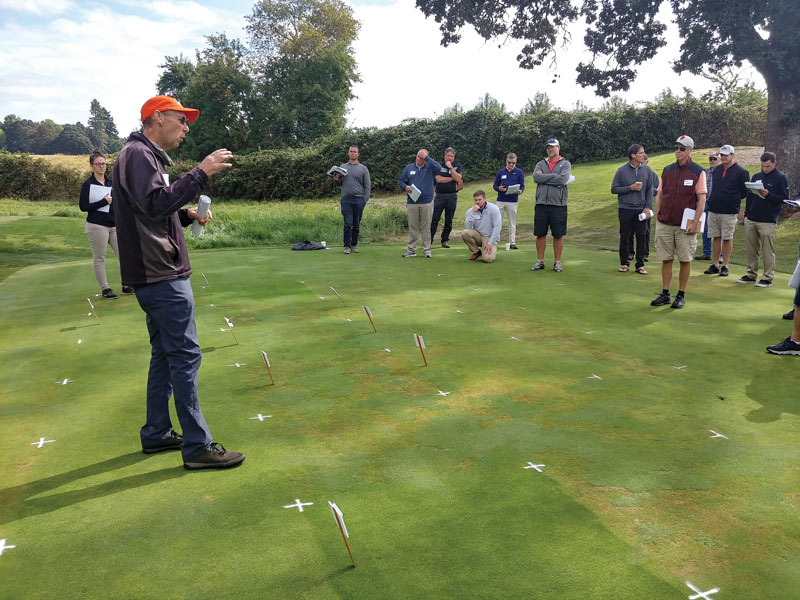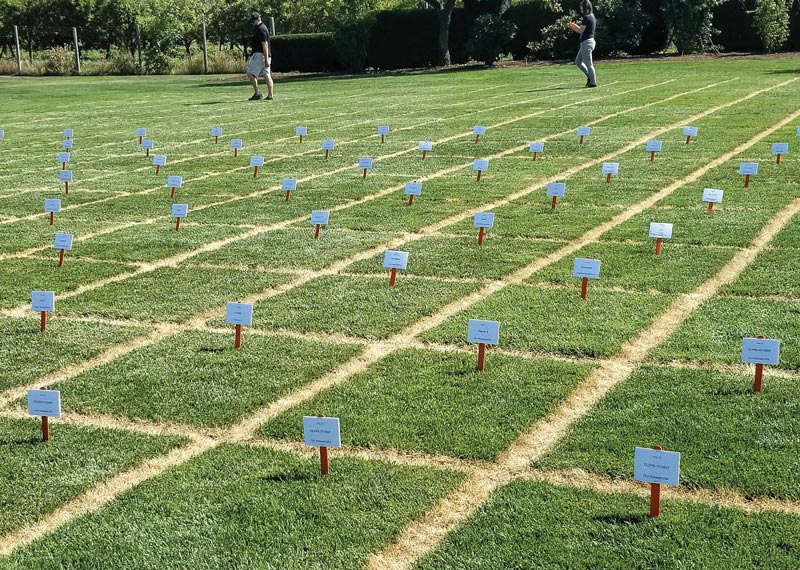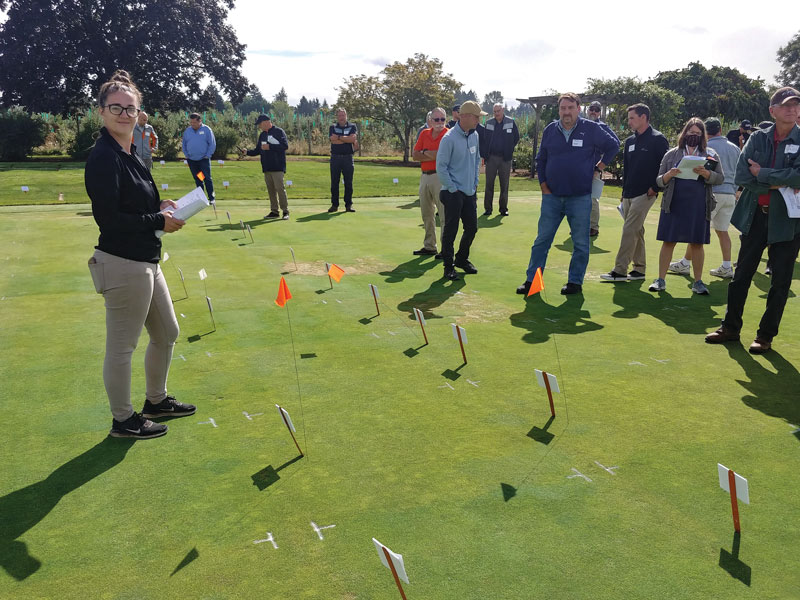
Brian McDonald (left), a senior research assistant in the turfgrass program at Oregon State University, walks visitors through an ongoing trial during a recent field day in Corvallis, Ore. McDonald’s research has focused on disease and weed control, annual bluegrass fertility, and PGR effects on putting greens, among other topics. Photos courtesy of Alec Kowalewski
Brian McDonald has been up close and personal with the turf management program at Oregon State University for more than two decades.
It’s a run that began in 1998, when McDonald — then 38 years old and looking for a change of scenery after 15 years in corporate accounting — came to Corvallis, Ore., to pursue a bachelor’s degree in horticulture, which he completed two years later. Not long after graduating, he took a job at OSU as a research assistant under the turf program’s longtime steward, Tom Cook. Save for the addition of “senior” to his title, McDonald’s role today is very similar to the one he assumed 21 years ago.
As a result, McDonald has a wholly unique perspective on the program, one topped only by Cook, who started OSU’s turf program in 1977 and oversaw it until his retirement in 2008. Between the two of them, they’ve seen every trial and tribulation, every accomplishment and accolade that has come the program’s way.
OSU’s turf program has always been short on resources but big on results. It has historically lacked the staffing and money afforded to the other leading turf programs it’s most often compared to. But what it hasn’t lacked is ambition and a track record of success and service to the turfgrass industry in the Pacific Northwest, a reputation that has never been lost on those who work as golf course superintendents, sports turf managers and lawn care operators in the region.
Those professionals have shown their appreciation for the program’s contributions to the region’s turfgrass scene by giving back. A steady stream of grants and donations has fueled the steady growth of OSU’s turfgrass research efforts. Those gifts have included funds donated by the Oregon GCSA and generated through GCSAA’s Rounds 4 Research program that have partially funded McDonald’s position in recent years.
It’s a level of generosity and appreciation for OSU’s role in the turf industry that leaves McDonald at a loss for words.
“I have so much respect for superintendents and all they’ve given me over the years,” he says. “It makes me feel good that the industry feels like the work I do here is valuable enough that they raise funds to help support my position. I’m not sure where I’d be and where the program would be without those Rounds 4 Research dollars.”
The little turf program that could
Oregon State’s story in turf has always been one of the underdog, the plucky upstart that has regularly punched above its weight class. For much of the program’s first two decades, it was up to Cook and Cook alone to balance the program’s three-pronged mission of education, Extension and research.
It was a task he accomplished with remarkable efficiency. During his tenure, the program produced more than 300 graduates who would go on to careers in golf, sports turf, or lawn and landscape management. That number is now closer to 400. Thanks to its Extension efforts, the program — and Cook in particular — became a trusted source of technical information and advice for superintendents and homeowners in the Pacific Northwest.

Ever wondered what impact the dollars raised through Rounds 4 Research have out in the field? Look no further than Oregon State’s turf management program. You can follow its research efforts, students’ activities and other updates on Twitter at @osubeaverturf.
And while select tests and trials, conducted either as a part of the student experience or at the behest of a commercial entity, were always a part of the plan at OSU, research often slipped down the priority list, the unfortunate victim of Cook’s one-man-band status and a lack of resources to balance all three missions adequately.
David Phipps, GCSAA’s field staff representative in the Northwest and a 1985 graduate of the turf program at Oregon State, remembers the work he did in the field as part of the classroom experience, but says longer-term and more in-depth research projects were few and far between during his years in Corvallis. “We always did a lot of our own stuff. It wasn’t true research, but it was more of just like a lab experiment. Just tests and trials. It wasn’t a real high-end research thing,” Phipps says.
The first step toward changing that was the hiring of McDonald in January 2001. The Northwest Turfgrass Association offered a three-year grant to help fund the position, with the hope that adding McDonald would give the program the ability to add new corporate contract research work, which, in turn, would provide funds that could be used elsewhere within the program.
Recent turf research from Oregon State
While appreciative of the industry support early in his tenure, McDonald didn’t necessarily think a long-term future at Oregon State was in the cards.
“I thought I would do this for a few years, and then I’d go and just become a golf course superintendent,” McDonald says. “But then I met my future wife, we got married, and I just grew to love this role and really enjoy the research, the exploration. I get a chance to do everything from fixing lawn mowers to research to speaking at conferences and cleaning bathrooms. When you’re a research assistant, you can’t have an ego about what you’re doing, which I think is probably true for superintendents, too.”
Watch: Brian McDonald discusses the OSU turf program’s long-standing partnership with Trysting Tree Golf Club in Corvallis, Ore., which affords students on-course experience and faculty an additional research site:
Alec Kowalewski, Ph.D., the current head of Oregon State’s turf program, says of McDonald, “People really do love Brian because of the years of research that he’s provided to them. He has this deep connection with the industry. I think that’s another thing that makes the program really successful. It can’t be just anybody. It’s got to be somebody that’s really involved and really close to the hearts of the industry in this part of the world.”
A lifeline from Rounds 4 Research
The same could be said for Tom Cook, and as he began to contemplate his retirement, there were concerns that without him as the program’s talisman, Oregon State’s turf program might well retire with him.
The state’s turf industry turned that concern into a call to arms and began to bolster fundraising efforts to increase its financial support of the OSU turf program. As the program transitioned from Cook to, first, Rob Golembiewski, Ph.D., and then Kowalewski in 2012, entities such as the Oregon GCSA began to up their games. The chapter spun off its long-standing foundation into the Oregon Turfgrass Foundation, with the specific goal of supporting education and research efforts.
Pledges to the OTF are largely composed of funding from the Oregon GCSA and Oregon Golf Association, as well as funds raised through individual and corporate donations and proceeds from an annual golf tournament. But when Rounds 4 Research, which auctions rounds of golf at venues around the country to support research-related activities, launched in 2012, the Oregon GCSA found another avenue to ensure its continued support of the OTF and the OSU turf program.
“For us as a chapter, the Rounds 4 Research is a ... program that we can capitalize on without competing with our foundation,” says Alexis Wenker, executive director of the Oregon GCSA and a 2003 graduate of Oregon State’s turf program. “We’re not trying to put on another raffle or another fundraising golf tournament. We’re not going to the same well again, so it’s really valuable for us in that sense.”

Emily Braithwaite (left), a research assistant at Oregon State University, joined the turf program in 2017. Rounds 4 Research funds dedicated to funding the position of her colleague, Brian McDonald, allowed the program to reallocate other funds to create her position. Braithwaite has conducted research on disease management on annual bluegrass greens and pest management strategies for reduced pesticide inputs.
From Oregon State’s perspective, Rounds 4 Research is an invaluable support system for the turf program’s overall mission. “It allows us to pay for Brian’s salary and then use the soft funds that we had to hire another technician (Emily Braithwaite),” Kowalewski says. “It’s allowed us to exponentially increase the amount of research we do and build the program larger and larger and take on more and more research. And now on top of Brian and Emily, we have three research associates. Rounds 4 Research gives us a base of solid income to help fund this team of people that are doing this big research effort for us.”
The Oregon GCSA is currently in year four of a five-year, $75,000 pledge to the OTF, which comes on the heels of what was a five-year, $125,000 commitment. And in each year of those pledges, Rounds 4 Research funds have accounted for 20% to 50% of the annual donation. “These R4R funds have been vital and an important revenue source to be able to continue supporting at these levels,” Wenker says.
The 2022 edition of GCSAA’s Rounds 4 Research auction — the 10-year anniversary — is set for April 25-May 1.
Scott Hollister is GCM’s editor-in-chief.